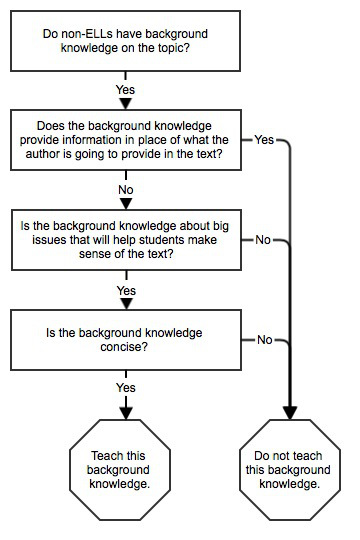Determining How Much Background Knowledge to Provide for ELLs
 This week, I'd like to focus on a topic that is getting a lot of attention in Common Core conversations: the role of background knowledge in reading instruction for ELLs. You may recall that close reading is one of the major shifts of the CCSS. I've been interested in the role that background knowledge plays in the close reading of text and wrote a post about it a few months ago. It's an issue that teachers, district leaders, policymakers, and curriculum writers seem to continue to struggle with when considering how best to teach ELLs within a CCSS-based framework.
This week, I'd like to focus on a topic that is getting a lot of attention in Common Core conversations: the role of background knowledge in reading instruction for ELLs. You may recall that close reading is one of the major shifts of the CCSS. I've been interested in the role that background knowledge plays in the close reading of text and wrote a post about it a few months ago. It's an issue that teachers, district leaders, policymakers, and curriculum writers seem to continue to struggle with when considering how best to teach ELLs within a CCSS-based framework.
I've heard opinions that span both ends of the continuum when it comes to deciding how much background knowledge is appropriate for ELLs - from no background knowledge whatsoever (and exclusive attention on the text) all the way to extensive preparation about the subject of the text, the author, or other topics that relate to the text.
"Letting the Text Take Center Stage"
There is a new article that can help shed more light on the role of background knowledge within the Common Core. It's titled "Letting the Text Take Center Stage" and was written by Tim Shanahan for the American Federation of Teachers' Fall 2013 American Educator magazine. Some state-level educators referred to the article a number of times at a meeting I recently attended, so I decided to give it a read. The article clearly describes some of the major relevant themes with reading in the CCSS and presents guidance that will be helpful to teachers.
In this post, I'll highlight some information from Shanahan's article about background knowledge. I'll then share a table and flow chart adapted from the article that will help you decide how much background knowledge to teach to ELLs. You can use these tools to make the process of figuring out how much background knowledge to teach a little less subjective.
A Little Background on Tim Shanahan
 What better way to start than with some background knowledge on our featured author? In case you're not familiar with him, Tim Shanahan is Distinguished Professor Emeritus of Urban Education at the University of Illinois at Chicago and is an expert on ELL literacy. (He has also served as an adviser to Colorín Colorado.) His stance on background knowledge for all students falls along the continuum I referenced earlier.
What better way to start than with some background knowledge on our featured author? In case you're not familiar with him, Tim Shanahan is Distinguished Professor Emeritus of Urban Education at the University of Illinois at Chicago and is an expert on ELL literacy. (He has also served as an adviser to Colorín Colorado.) His stance on background knowledge for all students falls along the continuum I referenced earlier.
In this particular blog post, he says that readers use what they know to interpret text, which supports teaching background knowledge where necessary. However, even though students use what they know when they read, he tempers his position on background knowledge by stating that any pre-reading activities should "give students as little preparation as required to engage with the text." In other words, providing students with background knowledge can't take the place of them making meaning from the text itself. This is especially true if the teacher is going to work with a text over time to help students understand it deeply.
Matching Kids to Texts and the Role of the ESL Teacher
In his article, Shanahan observes that, before the CCSS, English Language Arts content standards usually ignored the fact that some texts are harder to read than others. Until now, he writes, teachers have been taught to give students books at their instructional level. The CCSS constitute a reversal of that practice. Shanahan says there is not a firm base of research to support matching kids to texts. He says that while the student and text level do matter, the amount a teacher can support or scaffold a text is also important. (This should come as no surprise for ESL teachers!)
He says, "Under the CCSS, students will be more frustrated by challenging texts, and this means other instructional supports will be needed to help and encourage them along this path. Teachers must learn to anticipate text challenges and how to support students to allow them to negotiate texts successfully, but without doing the work for them." The needed expertise he outlines is exactly the kind of skill set many ESL teachers bring to the classroom. For example, Lily Wong Fillmore supports analyzing texts and spending time unpacking what she calls "juicy sentences."
If ESL teachers help content teachers in the ways Shanahan outlines, they'd be one step closer to fulfilling TESOL International Association's vision for the new role of the ESL teacher in the CCSS as expert, consultant, and advocate. However, ESL teachers may still need support in not doing all the work for their students so ELLs can gain more responsibility in negotiating texts.
Areas of Background Knowledge
Shanahan outlines two essential areas of background knowledge that teachers can effectively utilize with students. One area is providing background knowledge. Readers need to integrate prior knowledge with text information in order to form a mental representation or memory. This area has gotten more buzz with the CCSS in the context of close reading, as some have incorrectly interpreted this to mean that teachers may not provide any background knowledge at all.
A second area is activating existing prior knowledge. Existing prior knowledge is also a form of background knowledge, and teachers can draw upon what students already know when teaching in a CCSS framework. For example, teachers can use the title of a text as a springboard to help the students make a connection between the title and their existing knowledge of a topic without giving away the text. (See more in this related Colorín Colorado article.)
Deciding How Much Background Knowledge to Provide
When trying to decide how much background knowledge to teach ELLs in particular, it's important to figure out how critical the background knowledge is to ELLs understanding the text, even though that's not always easy to do. When you're considering pre-teaching some background about a text your ELLs will be reading, use the following table and flow chart to help you decide whether to teach this background knowledge. When conceptualizing how much background knowledge ELLs need within the CCSS framework, consider these four elements.
Checklist for Providing Background Knowledge to ELLs in CCSS-Based Instruction
Note: These tools build upon a rubric that Diane August created as part of her ongoing Common Core work in New York State.
| Background Knowledge Considerations | Comments |
|---|---|
| Do non-ELLs have background knowledge on the topic? | Teachers must ensure that ELLs approach the text with comparable levels of background knowledge that non-ELLs already have. If non-ELLs already approach the text with certain background knowledge, teachers should make sure ELLs have the same information. However, non-ELLs (as well as ELLs) will also need background knowledge to comprehend some texts. |
| Does the background provide information in place of what the author is going to provide in the text? | The background information provided can't give away the text. (No spoilers!) Students must gather information from the text itself instead of learning it from background knowledge the teacher provides. ELLs will still need support and scaffolding to gather information from the text itself. The next two considerations can help both groups of students. |
| Is the background knowledge about big issues that will help students make sense of the text? | Teachers must focus instruction only on the background knowledge that is critical to ELLs comprehending the text. ELLs don't need to know everything possible related to the topic. For example, ELLs don't need to be pre-taught all the vocabulary they will encounter in a text but will need to know key vocabulary that will help them unlock the meaning of the text. |
| Is the background knowledge you'd like to provide concise? | The more concise the background information is, the better (e.g., you may wish to reconsider taking an entire class period to build ELLs' background knowledge). For example, you could provide some background knowledge via homework that students complete prior to class time and briefly discuss the background the next day of class. |
Another way to work through how much background information to teach to ELLs prior to reading a text is to use the flow chart below.

What are your thoughts and experiences on providing background knowledge to ELLs in CCSS-based instruction? Are you hearing this topic debated or discussed in your local settings? We'd love to hear from you!








Comments
Pamela Pryor replied on Permalink
I think there may be a mistake on the flowchart graphic. It seems to me that the "Yes" and "No" at the second level "Does the background knowledge provide information in place of what the author is going to provide in the text?" are inverted. An answer of "yes" to that question should indicate the need to build that background knowledge.
Diane Staehr Fenner replied on Permalink
Hi Pamela, thanks for your message! I'm glad you took the time to review the flow chart carefully. While the flowchart is a work in progress, the "Yes" and "No" are actually in the right place in terms of the background knowledge providing information in place of what the author is going to provide in the text. Teachers shouldn't give the students background knowledge in place of what they'd like them to learn through the text they read. Essentially, teachers shouldn't give text "spoilers" through the background knowledge.
Anna S. replied on Permalink
New comment
I understand Pamela's concern, because I had the same thought. But, depending one what the objective of the lesson is, no additional background is needed. I would maybe provide additional background - that is not given in the text - on a second or third read, and ask students to view the text with a new perspective to challenge their thinking.
Add new comment